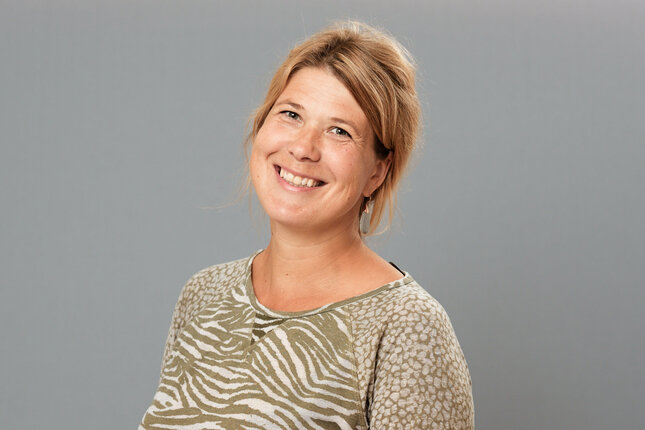The combination of light-based and electronic components on a single computer chip would have many benefits for our computing needs. Chips would be faster and consume less energy when using light. However, the problem with current silicon-based technologies is that they cannot emit light. TU/e full professor Erik Bakkers has big plans to change that, though. Along with colleagues at TU Munich and the University of Twente, the research team has just been awarded a €14 million ERC Synergy grant. €5 million will be used to back groundbreaking research at TU/e, with Bakkers coordinating the international project.
"Light-emitting chips is the holy grail of future computing technologies - the realization of these chips could revolutionize computing technologies."
That's how Erik Bakkers - Full Professor at the Department of Applied Physics and Science Education - views the promise of light-emitting microchips.
SiGe holds the key
To get to the promised land, though, a fundamental property of the materials used to make our microchips needs to change.

"We must change how atoms are arranged relative to each other. In technical terms, we need to move away from the natural cubic structure of many materials to one that is based on the hexagonal arrangement of atoms. If we achieve this, the materials will be able to emit light."
This is the central goal of the project 'Bright Chips', a collaboration between Bakkers, Professor Floris Zwanenburg from the University of Twente, and Professor Jonathan Finley from the Technical University of Munich. The project has just received significant funding to the tune of €14 million as part of the ERC Synergy grant initiative.
The material of choice for the 'Bright Chips' project is silicon germanium (SiGe) - an alloy that has been shown in recent years to have the suitable properties to emit light.
Three's not a crowd
"We want to understand how and why SiGe emits light, both from a classical and quantum physics perspectives," says Bakkers. "Our project is a truly multidisciplinary project which combines the worlds of materials science, photonics, and electronics. And each member of the 'Bright Chips' project team will focus on one of these three topics."
At TU/e, the Bakkers' team will fabricate a new material system based on hexagonal SiGe. Thereafter, the team at TU Munich led by Jonathan Finley will characterize the new SiGe material, and using the material, they plan to demonstrate single photon emitters and lasers.
Finally, at the University of Twente, Floris Zwanenburg's group will fabricate and measure the performance of electronic devices that incorporate the SiGe light-emitting components.
"A major milestone or goal for Bright Chips is to study optically-connected SiGe-spin qubits. These can be quickly changed, upscaled, and they are expected to be long-lived due to the unique properties of the materials we will work with," says Bakkers. "We're excited to get started with the project!"

Making blood cells
The second project with TU/e involvement to get an ERC Synergy grant is 'MakingBlood'. Cecilia Sahlgren , a part-time Full Professor at the Department of Biomedical Engineering and mainly based at Åbo Akademi University in Finland, is one of the four principal investigators on the project.
"MakingBlood is seeking to make human blood stem cells (also known as hematopoietic stem cells) using human pluripotent stem cells," says Sahlgren. "At present, blood stem cells are collected from donors."
"However, too often, a suitable stem cell donor cannot be found. We will explore the cellular, molecular, and physical features that are important for the generation of blood stem cells. Lessons learned here will be used to make blood cells in the lab using a dedicated in vitro setup."
TU/e will play two roles in the project. First, researchers will manufacture a high throughput approach to control flow with magnetic cilia, which will be used to build the embryonic niches that are important for the formation of blood stem cells in the human embryo.
This will be done in collaboration with Ye Wang , who is based in the group of Jaap den Toonder at the Department of Mechanical Engineering.
Second, researchers will create in vitro models of the embryonic niches where blood stem cells are formed in the embryo. The 'MakingBlood' project is coordinated by the Hospital del Mar Research Institute in Barcelona, Spain, by Professor Anna Bigas.
The other principal investigators are Gerald de Haan, Research Director of Sanquin, the Dutch Blood Bank, and Dr Cristina Pina, Senior Lecturer in Biomedical Sciences at Brunel University.
About the ERC Synergy Grant
A group of two to a maximum of four Principal Investigators (PIs) working together and bringing different skills and resources to tackle ambitious research problems. One will be designated as the corresponding PI (cPI).
No specific eligibility criteria regarding the academic training are foreseen for ERC Synergy Grants.
PI's must present a competitive track record that is appropriate to their career stage. Proposals are evaluated on the sole criterion of scientific excellence , which takes on the additional meaning of outstanding intrinsic synergetic effect.






